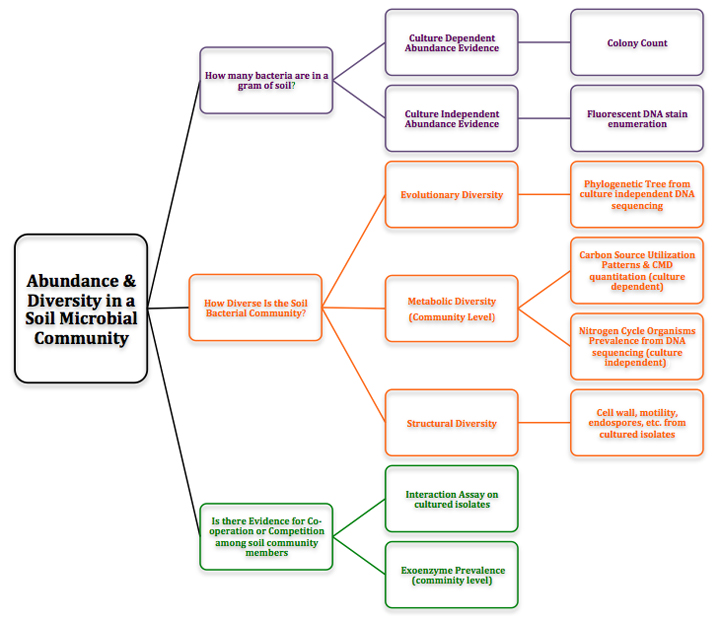BISC209/F13:Project: Difference between revisions
Tucker Crum (talk | contribs) |
Tucker Crum (talk | contribs) |
||
| Line 31: | Line 31: | ||
==<center>Strategy for Analysis of Soil Community Bacteria</center>== | ==<center>Strategy for Analysis of Soil Community Bacteria</center>== | ||
[[Image: | [[Image:Schema13E2.jpg]]<BR> | ||
[[Media:schema_13e.docx]] <br> | [[Media:schema_13e.docx]] <br> | ||
Revision as of 05:07, 18 September 2013
Project: Soil Microbial Communities
In this series of nine labs you will learn:
- To think, work, and write as microbiologists
- To use the basic tools and techniques of traditional and molecular microbiology
- To investigate the diversity, identity, and function of soil bacteria
- To make careful, unbiased observations and to record and analyze them for meaning and importance
- To design controlled experiments and collect data from those experiments to answer questions that arise from your observations
- To show data in effective figures or tables
- To make and articulate conclusions from experimental results
- To write intelligibly in scientific research report format about your investigation and its conclusions, including its significance or implications
Introduction to the Project
Your goal in this semester long project is to use both culture-based and culture-independent methods to investigate the abundance and diversity of bacteria in a soil community and to explore how this population functions as a community, both co-operatively and competitively. We want to detect examples of ways that microbial soil community members support and exploit each other and their eco-system.
Project Overview
Our semester long investigation explores abundance and richness in a soil microbial community.
Our lines of investigation are three fold:
- Abundance : How many microbes are in our soil comunity?
- Richness : Is the soil community diverse and, if so, in what ways?
- Community Behavior: How do the microbes living in an unbelievably crowded soil communities co-operate and/or compete to find and maintain a niche?
In order to provide evidence to answer these broad, complex questions, we will isolate DNA from a soil sample and process it for culture-independent, next-generation, high-throughput DNA sequencing to get a picture of "who" comprise the community of soil bacteria and the relative prevalence of certain types of bacteria in this community. We will assess abundance by enumerating the microbes in a soil sample by two different methods to quantitatively measure the number per gram of soil. We will test a soil extract for microbial community metabolic diversity in carbon source utilization. We will try to obtain relative prevalence information on bacteria in the community that secrete valuable exoenzymes or contribute to the nitrogen cycle. We will isolate a few members of the soil bacterial community to pure culture to test for several indicators of structural diversity and possible positive or negative interactions among them.
Strategy for Analysis of Soil Community Bacteria
We would like to thank Irene Newton, William VonSiegler; Charles Deutsch, Patricia M. Steubing; Stephen C. Wagner and Robert S. Stewart, Jr.; Kyle Seifert, Amy Fenster, Judith A. Dilts, and Louise Temple; and the instructors of the Microbial Diversity Course at the Marine Biological Lab in Woods Hole, MA for their valuable assistance in the development of these labs.

